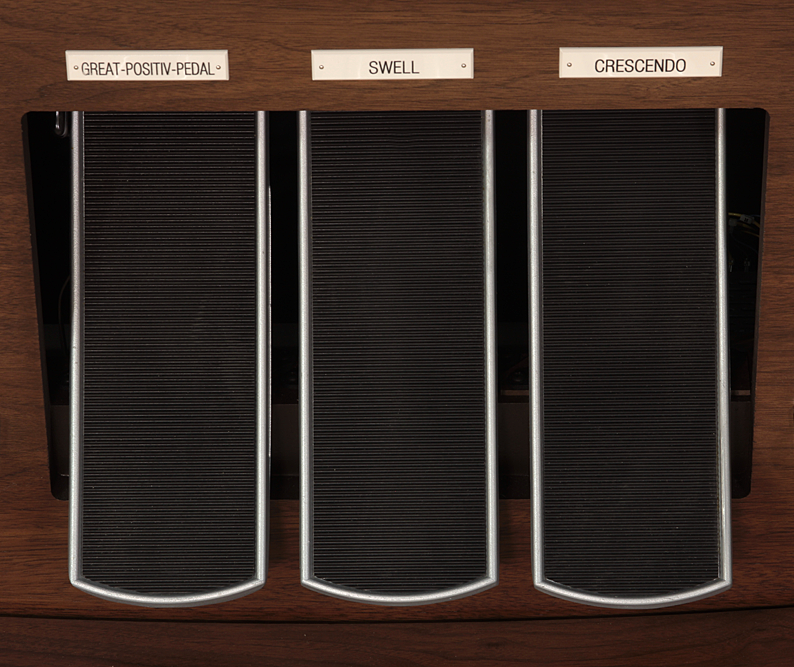What is a Hybrid Organ?
A hybrid organ is made up of both traditional wind-blown pipes and digital sounds, based on recorded samples of sound from real pipe organs. A well-designed hybrid organ consists of both pipe and digital stops, selected to complement each other and blend seamlessly into a single instrument.
This document contains a discussion of organ design, advantages and scenarios related to hybrid organs, and a selection of case studies of hybrid organ installations.
Design Considerations
Organ building has been an art for hundreds of years and has evolved rapidly in the computer age. Here is an overview of some of the key elements of modern organ building:
STOPS

An organ “stop” is a characteristic sound, such as a flute, trumpet, stringed instrument, or principal (“organ sound”). Organs range in size from a few stops to 100 or more.
In a traditional pipe organ, most stops consist of a set of pipes, one for each note on the keyboard (usually 61). These pipes are positioned on a chest filled with compressed air provided by an electric blower. The pipes, chests, and blowers can take up a lot of space, especially if the organ has many stops.
In a digital organ, stops are embodied by data which is processed by a computer within the console. The sound is rendered on external speakers, which are placed strategically to provide the desired effect in the space. The digital stop data comes from sample recordings of a particular pipe stop on an exemplary traditional pipe organ.
Frequently, organs are described by their number of “ranks”. A rank is a row of pipes that have the same tonal quality, at different pitches. Most stops (the sound) are realized through a single rank of pipes. Some specialized stops are made up of multiple ranks of pipes, so that when the organist presses a key more than one pipe is played.
Pipe organs are limited by space. Digital components can be added to a pipe organ with minimal space requirements.
VOICING

The act of adjusting the sound of each individual pipe or digital equivalent is known as “voicing”. This is needed to provide consistent sound quality and volume through every note within the stop. It also ensures that the various stops of the organ complement each other.
For example, some sets of stops work together to form a “chorus”. If one of those stops has a different tone or is louder than the others, the effect of a unified chorus will be ruined.
Voicing is an art that requires an expert. Pipes are voiced by changing the physical characteristics of the pipe to achieve the desired sound. Digital stops are voiced using computer software to change the sound, including its volume, tone, and reverberation. With Allen Organs,voicing can be done on site, making it convenient to seamlessly blend with the pipe stops, and to reflect the acoustics of the space.
Voicing enables the pipes and digital components of hybrid organs to sound like a single instrument.
CONSOLE
All types of organs (pipe, digital, hybrid) are played from an organ console. The organist can select the stops and other options, control the volume, and play the music on the keyboards.

To make all this work, modern consoles have a computer control system. When the organist selects a pipe stop and depresses a key, the control system causes air to be released into the appropriate pipe, making a sound. For a digital stop, the control system selects the appropriate sound from its digital sample data, manipulates it as needed to achieve the desired characteristics defined during voicing, and renders the sound to a speaker.
The console allows the player to control both pipe and digital stops, seamlessly.
VOLUME CONTROL

Pipes speak with a constant volume. To achieve dynamic expression, some pipes may be hidden behind a set of shades, similar to large wooden blinds, that the organist can control via an expression shoe to dampen the sound. The organist can also change the volume by adding or deleting stops.
Digital stops have a continuous range of volume control, achieved when the sound is sent to the speaker. In a hybrid organ, the expression shoes control both the volume of the digital stops and the position of the shades for pipe stops.
A hybrid organ has enhanced volume control over a traditional pipe organ.
